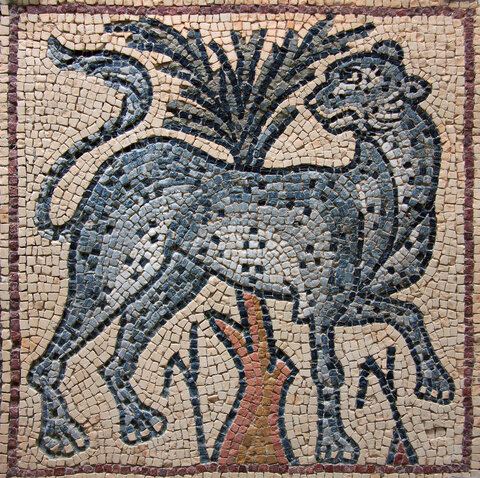BYZANTINE period.
Byzantine Period
Emperor Justinian of Constantinople, was the Byzantine emperor from 527 to 565 CE, who sought to realise the "Restoration of the Empire" by recovering the lost Western territories of the former Roman Empire. To realise this ambition, his general, Belisarius, sailed to North Africa in 533 with 15,000 men to reclaim the former Roman territories in North Africa, which had been taken by the Vandals. They landed at Caput Vada (now Ras Kaboudia) in what is now Tunisia. The Byzantines easily defeated the Vandals, ruled by King Gelimer, at Ad Decimum in September 533, who were not expecting the Byzantine army, and took the important metropolis of Carthage in 534 where they established a prefecture from which they ruled over the region1.
Byzantine Horsemen - Mosaic Image, Cyrenaica
However, the start of Byzantine rule was also marked by instability, and the region was severely depopulated by a disastrous trio “sword, famine and pestilence." The Berbers, who had, in the chaos of the declining Roman Empire and Vandal attacks, gained independence and strength, fought Byzantine control, and were placed under burdensome taxations and levies, which triggered further Berber rebellion2. The dire situation was exacerbated by the arrival of the plague in 541, which swept westward across North Africa from Egypt. The Justinian plague, as it was later called, was thought to be a variety of the bubonic plague, caused by the bacteria ‘Yersinia Pestis’. The plague had a tremendous impact economically on the Byzantine Empire which was still predominantly agrarian and depended heavily on taxation, the decimation of agricultural communities resulted in both a shortage of grain and tax revenues. The years that followed were plagued by famine across the empire in 542 and between 545 and 5463.
Gold Roman solidus coin of Roman Emperor Justinian
After a century of Byzantine rule, marked by plague and famine and continuous attacks by the Berber tribes, the great Roman cities of Sabratha and Leptis were severely depopulated, and its great public infrastructure such as the road systems, aqueducts, water channels, sewer systems and buildings were laid to ruin. Government efforts to restore the Eastern cities of Libya through various civic and religious programs do not appear to have been successful. Half-hearted initiatives to restore Sabratha and Leptis by erecting protective walls around the old towns were not effective in restoring them to their former glory4.
Justinian missionaries were sent from Tripolitania into the interior area of Fezzan, to Christianize the Berbers. However, no evidence exists as to whether such missionary expeditions were successful and Berber nationalism grew in strength and organization, eventually leading the Byzantine empire to focus on governance of the coastal areas of North Africa, and leaving the interior to the Berbers, thus Saharan trade fell as a consequence of the political break along commercial trade lanes5.

Byzantine Mosaics, Cyrenaica.

Byzantine Mosaics, Cyrenaica.

Byzantine Mosaics, Cyrenaica.

Byzantine Mosaics, Cyrenaica.
Archaeological site of Apollonia,the Byzantine basilica, Leptis Magna
FOOTNOTES.
Wikimedia Foundation. (2021, July 28). Justinian i. Wikipedia. https://en.wikipedia.org/wiki/Justinian_I.
Oyeniyi, Bukola Adeyemi. The History of Libya. Santa Barbara, CA: Greenwood, 2019.
Wikimedia Foundation. (2021, July 12). Plague of justinian. Wikipedia. https://en.wikipedia.org/wiki/Plague_of_Justinian.
Wright, John. ‘A History of Libya’ . Oxford University Press. 2012.
ibid.
ibid.


